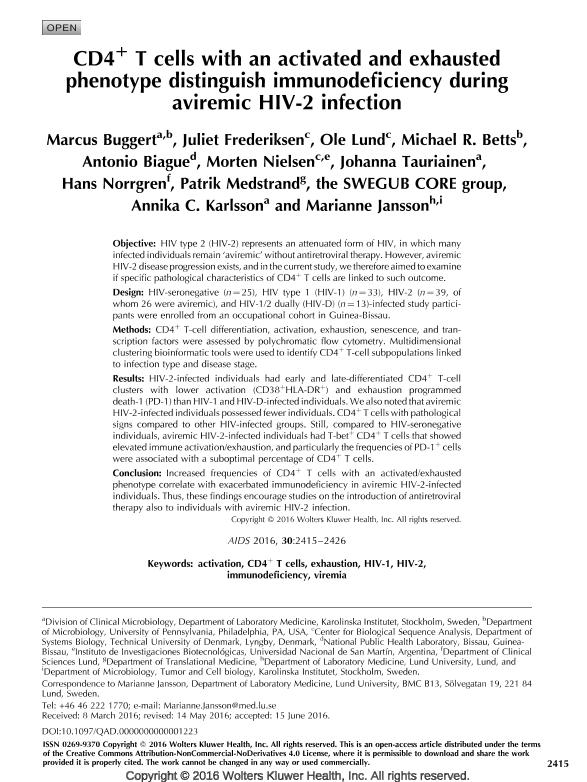Artículo
CD4+ T cells with an activated and exhausted phenotype distinguish immunodeficiency during aviremic HIV-2 infection
Buggert, Marcus; Frederiksen, Juliet; Lund, Ole; Betts, Michael R.; Biague, Antonio; Nielsen, Morten ; Tauriainen, Johanna; Norrgren, Hans; Medstrand, Patrik; SWEGUB CORE group; Karlsson, Annika C.; Jansson, Marianne
; Tauriainen, Johanna; Norrgren, Hans; Medstrand, Patrik; SWEGUB CORE group; Karlsson, Annika C.; Jansson, Marianne
 ; Tauriainen, Johanna; Norrgren, Hans; Medstrand, Patrik; SWEGUB CORE group; Karlsson, Annika C.; Jansson, Marianne
; Tauriainen, Johanna; Norrgren, Hans; Medstrand, Patrik; SWEGUB CORE group; Karlsson, Annika C.; Jansson, Marianne
Fecha de publicación:
10/2016
Editorial:
Lippincott Williams
Revista:
Aids
ISSN:
0269-9370
Idioma:
Inglés
Tipo de recurso:
Artículo publicado
Clasificación temática:
Resumen
Objective: HIV type 2 (HIV-2) represents an attenuated form of HIV, in which many infected individuals remain 'aviremic' without antiretroviral therapy. However, aviremic HIV-2 disease progression exists, and in the current study, we therefore aimed to examine if specific pathological characteristics of CD4 T cells are linked to such outcome. Design: HIV-seronegative (n = 25), HIV type 1 (HIV-1) (n = 33), HIV-2 (n = 39, of whom 26 were aviremic), and HIV-1/2 dually (HIV-D) (n = 13)-infected study participants were enrolled from an occupational cohort in Guinea-Bissau. Methods: CD4+ T-cell differentiation, activation, exhaustion, senescence, and transcription factors were assessed by polychromatic flow cytometry. Multidimensional clustering bioinformatic tools were used to identify CD4+ T-cell subpopulations linked to infection type and disease stage. Results: HIV-2-infected individuals had early and late-differentiated CD4+ T-cell clusters with lower activation (CD38+HLA-DR+) and exhaustion programmed death-1 (PD-1) than HIV-1 and HIV-D-infected individuals. We also noted that aviremic HIV-2-infected individuals possessed fewer individuals. CD4+ T cells with pathological signs compared to other HIV-infected groups. Still, compared to HIV-seronegative individuals, aviremic HIV-2-infected individuals had T-bet+ CD4+ T cells that showed elevated immune activation/exhaustion, and particularly the frequencies of PD-1+ cells were associated with a suboptimal percentage of CD4+ T cells. Conclusion: Increased frequencies of CD4+ T cells with an activated/exhausted phenotype correlate with exacerbated immunodeficiency in aviremic HIV-2-infected individuals. Thus, these findings encourage studies on the introduction of antiretroviral therapy also to individuals with aviremic HIV-2 infection.
Palabras clave:
Activation
,
Cd4+ T Cells
,
Exhaustion
,
Hiv-1
,
Hiv-2
,
Immunodeficiency
,
Viremia
Archivos asociados
Licencia
Identificadores
Colecciones
Articulos(IIB-INTECH)
Articulos de INST.DE INVEST.BIOTECNOLOGICAS - INSTITUTO TECNOLOGICO CHASCOMUS
Articulos de INST.DE INVEST.BIOTECNOLOGICAS - INSTITUTO TECNOLOGICO CHASCOMUS
Citación
Buggert, Marcus; Frederiksen, Juliet; Lund, Ole; Betts, Michael R.; Biague, Antonio; et al.; CD4+ T cells with an activated and exhausted phenotype distinguish immunodeficiency during aviremic HIV-2 infection; Lippincott Williams; Aids; 30; 16; 10-2016; 2415-2426
Compartir
Altmétricas



